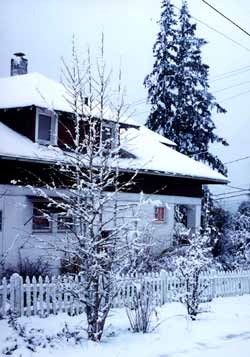
Turkish Filbert
"The trees along this city street,
Save for the traffic & the trains,
Would make a sound as thin & sweet
As trees in country lanes."
-Edna St Vincent Millay
(1892‚1950)
(1892‚1950)
I loved especially the winter look of the Turkish Filbert (Corylus colurna), leaflessly forming an inverted black-lightning silhouette against a milky December sky.
The most outstanding feature is seen only on mature trees: the gnarly ridged & deeply furrowed corky bark, silvery grey & quite dramatic. Ours was at the middle-age when the bark is most extremely cracked & scored. As a trunk thickens & further ages, some of the bark will flake off revealing more of the smooth orangish-brown bark beneath.
Its autumn yellows were very attractive some years, but usually only moderately so, the leaves often being only pallid yellow or brown. Its spiky-husk-encased filberts are the more interesting early-autumn feature. The husked nuts fall from the tree by October, then in November the whole tree turns yellow. Its best fall colors can be seen on the Turkish Filbert page of the Autumn Trees Garden Walk.
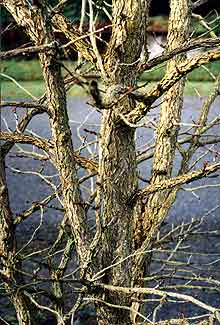 Spring & summer it looked a bit like a hornbeam or a littleleaf linden. Spring & summer leaves are a lush green. Turkish filberts have a naturally pyramidal shape, growing more oval with age, & never requires pruning.
Spring & summer it looked a bit like a hornbeam or a littleleaf linden. Spring & summer leaves are a lush green. Turkish filberts have a naturally pyramidal shape, growing more oval with age, & never requires pruning.For the first couple of years it didn't produce the catkins or nuts, but finally it did have attractive catkins for autumn & winter. The catkins or male flowers start off short & hard & are very evident scattered throughout the tree in September. By February these have lengthened into extremely pretty soft brown chains, as seen in the February catkin photo.
The female flowers are so small they can easily pass unseen, but in the catkin photo you'll see the tiny fuchsia-pink blooms. These appear in late February. Once pollinated, these teency flowers very slowly develop into filbert nuts. By the next September, the spiky-husked nuts approach harvestable ripeness & tumble to the ground, at the same time new young catkins are filling the branches anew.
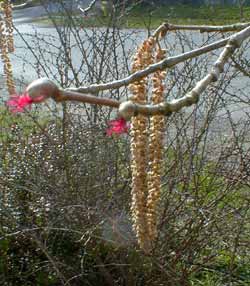 Though an exceedingly hardy tree adaptable to considerable extremes, they're nevertheless sometimes severely shocked by being moved, & ours underwent a greater than average shock when it was first planted, from which it never completely recovered.
Though an exceedingly hardy tree adaptable to considerable extremes, they're nevertheless sometimes severely shocked by being moved, & ours underwent a greater than average shock when it was first planted, from which it never completely recovered.When we obtained it, it was already a substantially mature tree with enormous rootball, too much for Granny Artemis & I to manipulate. So we hired a chap who worked at the nursery, who claimed to be a landscaper expert at installing trees & building ponds & all what-not.
Fabian (let us call him) had some missing front teeth, some religious fruitcake notions, & could be embarrassingly personal about what was going on in his life. But I was charmed by the fellow & no red flags went up. We later heard from all & sundry that he was notoriously unqualified & inept. He also told us he'd get the tree in for us for $40 but ended up charging us three times that, but that's another matter.
He dug a hole that was more like a socket, & he broke off part of the fence when he let the tree fall hard on its side, beating the crap out of the tree at every opportunity. I tried to stop him from inserting the rootball into the tight hole, insisting the hole should be wider than the rootball, especially since the soil was so hard-packed at the roadside. But he went into high macho-cretinism mode about how he was an expert who knew what he was doing as he proceded (upon discovering the rootball wouldn't fit in the narrow hole at all) to hack off many of the roots to make the ball smaller.
Then when he hoisted the tree & dropped it in the hole, it was a good eight inches too deep! It really had to be taken out & repositioned rather higher in the ground, but Fabian wasn't about to do that right either.
This was one of the first trees we installed when we first bought the house, & I learned from the horrible experience to always dig my own holes & not have anyone else to do it. One other tree which we obtained was too big for us to install by ourselves, but I dug the hole before that one was even delivered, never again trusting the work to self-proclaimed experts.
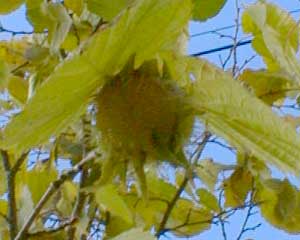 Fabian had pretty murdered the tree. The nursery guaranteed its trees for a year. But a tree can take three to five years of lingering decline to be killed by the kind of maltreatment imposed on the poor thing by that incompetent "expert," which is in great part the reason nurseries can guarantee trees for one year.
Fabian had pretty murdered the tree. The nursery guaranteed its trees for a year. But a tree can take three to five years of lingering decline to be killed by the kind of maltreatment imposed on the poor thing by that incompetent "expert," which is in great part the reason nurseries can guarantee trees for one year.It was such a burden to worry whether or not that incompetent Fabian had killed the filbert. It's an unusually hardy species, so we convinced ourselves it could adjust to having its root crown too deep, having had most of its rootball hacked off, & having been put in a hole one-third the width it required. In consequence of the shock, it did not produce its male catkins until three years at its new location, no filberts until the autumn after that. Its last two years with us, it produced gazillions of filberts, which we wanted to take as an indication that it had indeed settled in nicely, though I well knew that many a tree will strive like mad to reproduce itself just before it dies.
At the end of three years, one of its three trunks that had provided it with such perfect symetry was dead. A second of its three previously-gorgeous trunks was obviously failing, & was dead in its fourth year. We still nurtured hopes that the third trunk would survive & fill out to reclaim some of the tree's former beauty, but that fifth spring, it did not releaf. We had no choice but to take down the last trunk, & replaced the turkish hazel with a strawberry tree (Arbutus unedo).
I have sometimes felt that if I saw that fraud landscaper run over on the side of the road, I'd pull over & get out of my vehicle to stomp on his corpse. I wasn't surprised when he got fired from a series of nursery jobs for scams or incompetence, & when years later he turned up in yet another nursery, I had to fight the urge to give him a full dressing-down or take a paddle to his fanny. Detecting my & Granny Artemis's tension when he became especially friendly, he looked a little wounded, but his past crimes must've come flooding back into his memory, as before we left, he'd given us a box full of succulents without charge, since the owner was not there to stop him. A scant month later, he was fired from that job too.
Some Turkish Filberts never do produce filberts, & we were willing to accept that ours might never. When in 2003 it produced a great many of them, it was such a delight. The half-inch very hard filberts are inside horsechestnut-like husks (or thick enclosing bracts) that expand the size of the fruit to an inch & a half round. These appear in great numbers, & delighted our neighborhood squirrels.
Removed from the husks, the nuts are edible, though so extremely hard with such small amount of meat within it's hardly worth the struggle to break them open. We didn't bother to harvest ours at all except a few for curiosity sake, but were happy to have them for the local squirrels which we have encouraged in our yards & hope will someday make dreys in our trees.
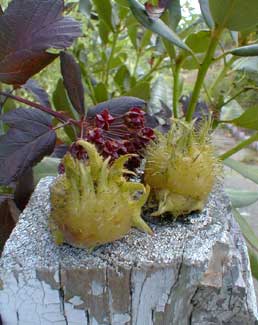 The unhusked filbert photos from September (2003) show one of the fruits still on the tree. By September eighth or tenth these were already falling to the ground in considerable numbers.
The unhusked filbert photos from September (2003) show one of the fruits still on the tree. By September eighth or tenth these were already falling to the ground in considerable numbers.Though this is one of the most recommendable of roadside trees requiring little to no maintenance, the potential for heavy production of big round-husked filberts can sometimes force a bit more clean-up to keep these falling fruits off the sidewalks, & some folks may be glad to have a specimen that does not produce scads of nuts. To me they did add to my delight in this tree, before its decline made it an emotional burden to me. Even though in the past I convinced myself it wouldn't matter if it never fruited, when it was finally settled in sufficiently to do so, I was exceedingly thrilled, despite the sinking suspicion that it had become fruitful as prelude to the pending decline.
I placed some of the nuts on a fence post in front of a Diablo Ninebark, & took a more careful portrait to show the fruits' "alien eggs from outer space" strangeness in detail. Dried ninebark seeds are dangling into the portrait last on this page. The branch of a broadleaf evergreen in the background is from a 'Nova Zembla' Rhododendron.
This native of southeastern Europe & western Asia is a slow-grower to 30 or 40 feet or even taller. The photo at the top of this page shows our lamented filbert on a snowy day during its first winter by our house, before that area had become a well-planted sun-garden.